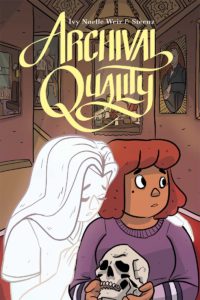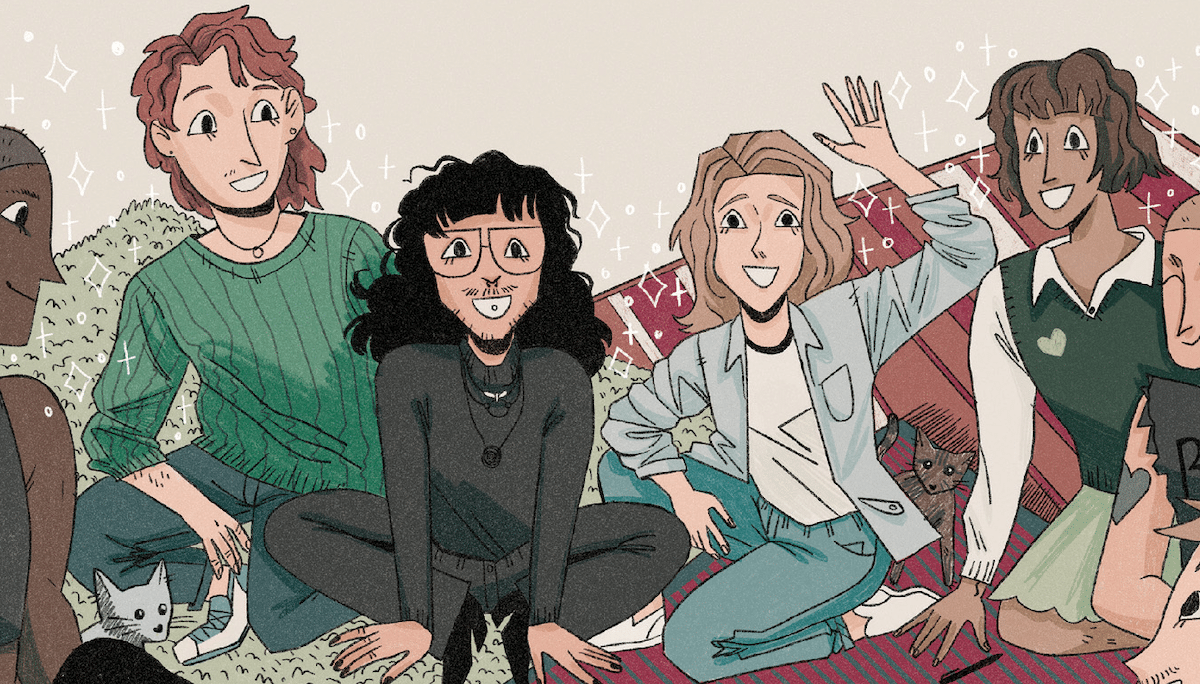Welcome to Queerness in Comics, a bi-weekly column by Avery Kaplan that will explore queer representation in comics. This week, Avery is exploring Archival Quality, a graphic novel published in 2018. Archival Quality was awarded the 2018 Dwayne McDuffie Award for Diversity in Comics and was a Junior Library Guild Selection.

Artist: Steenz
Publisher: Oni Press
Archival Quality by Ivy Noelle Weir & Steenz is a ghost story about haunting in every sense of the word. Not only is there the literal, supernatural haunting that drives the story’s plot, but there’s plenty of personal hauntings, as well. Celeste “Cel” Walden is haunted by her past at the library and her struggles mental health, while Abayomi can’t move beyond the mysterious disappearance of his mentor. Even Holly, the museum librarian, keeps secrets: her girlfriend, Gina, conceals their relationship from her father, who is a member of the museum board. In Archival Quality, the secrets that people have attempted to keep will inevitably make their way to the surface – but even before that, when still submerged, these hidden elements nevertheless have an effect.
Cel’s Situation
Cel, the protagonist of Archival Quality, is the reader’s perspective into the story. From the very first page, it’s clear that Cel is struggling with her mental health. By her own account, there have been a number of different clinic labels affixed to her situation over the years, including depression, generalized anxiety, and bi-polar. However, a metaphor is used to describe her emotional state: the wall that surrounds a beach town to protect it from rising tides. According to Cel, the waves of despair may not be able to make it through the wall, but they do leave their mark on it once they’ve receded.

After an incident involving her mental health leads to the loss of her job as a library assistant, Cel responds to an ad for a position at the Logan Museum, which specializes in medical history. The gig comes with an onsite apartment since the hours of the museum dictate that the work must be completed at night. While the position seems like a big change, that’s just what Cel is looking for in her life, and she gladly accepts the chance to “restart her life” under new circumstances.
Return of the Repressed

However, once she begins work at the Logan Museum, she soon begins witnessing spooky, inexplicable phenomena. Boxes of files are knocked over even though no one is in the room, medical samples suddenly become “misplaced” even though Cel has not touched them, and pounding noises can be heard in the night.
Eventually, Cel convinces her new friends (and fellow employees at the Logan Museum) to help her investigate the source of the occurrences. In particular, she turns to Holly to help her determine the identity of the mysterious specter. At first, Cel can offer very little information to help narrow down the possibilities. She tells Holly that she may have been in her 20s or 30s, unless she was younger (or older).
Ultimately, they discover the source of the sounds, tracing the supernatural disturbances to a former “patient” of the sanatorium that once occupied the property. The late Celine Wanamaker was not only subjected to questionable medical procedures during her time at the sanatorium, after her death, her remains were divided.
The Logan Museum’s Board of Directors had concealed the enterprise that was the actual source of income for the organization: selling human remains on the black market for large profits. While the Board had attempted to keep this enterprise concealed from sight, forbidding employees to access the third floor where they held their meetings and hid some of the more obvious and disturbing examples of misappropriated body parts.
However, in spite of the Board’s attempt to hide their endeavor, the efforts of the ghost ultimately force the exploitation out of the dark and into the metaphorical sunlight – and the literal sunlight, as Cel’s liberation of Celine’s remains causes the Logan Museum building to go full House of Usher.
The Secrets We Keep
Concurrent with the hidden agenda of the Board of Directors are the details that the characters themselves are hiding. Abayomi, the chief curator, is something of an unwilling participant in the illegal activities being undertaken by the Board. When Abayomi first began working for the Logan Museum, it was under the guidance of Dr. Weston, a kind man who became a sort of mentor figure. However, Weston eventually vanished without explanation, and Abayomi replaced him as the Board’s right-hand man. The Board forces Abayomi to keep their secrets with threats, suggesting that just as Weston disappeared, Abayomi might be made to vanish, as well.
Likewise, Holly and Gina are forced to keep secrets, as well. Since Gina’s father is a member of the Board of Directors, she insists that her relationship with Holly be kept a secret. The specific reason for this concealment is given several hypotheses – concern about workplace retaliation or garden-variety bigotry are proffered as potential explanations – but no definitive explanation is given.
Ultimately, the secrets that have been concealed by the Board are brought to light, and with them, the secrets kept by Abayomi, Holly, and Gina are brought to light, as well. Just as concealment begets concealment, openness leads to more openness, and the efforts of the ghost to bring her own truth to bear have an effect on the secrets of the living, as well.
Archival Quality is a spooky, lingering meditation on the way certain things just won’t stay buried, and the ultimate catharsis of allowing them to come to light.
Disclosure: The Beat is owned by Polarity, which also owns Oni Press.










Comments are closed.